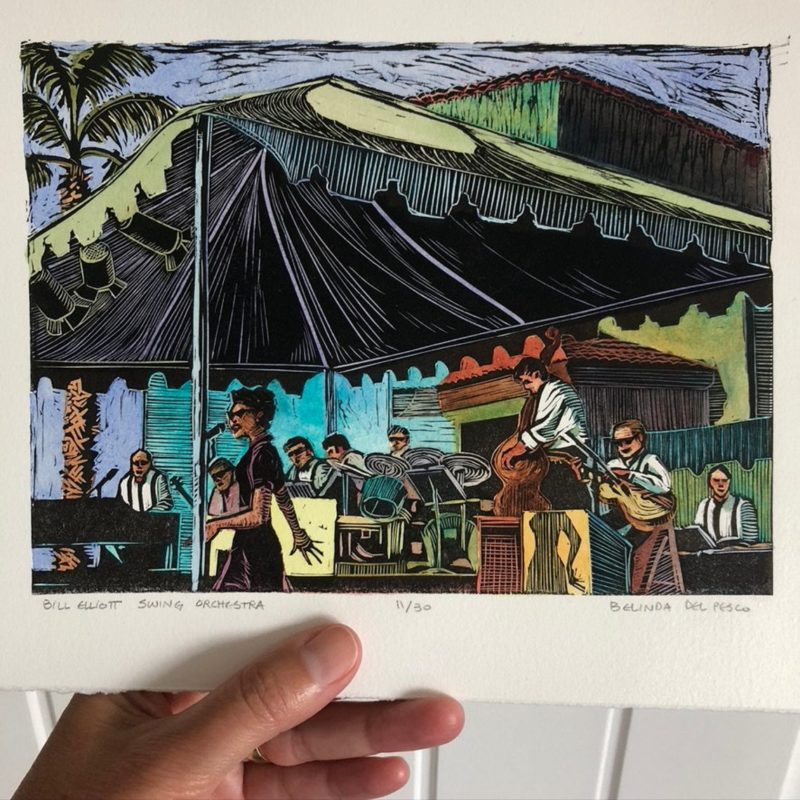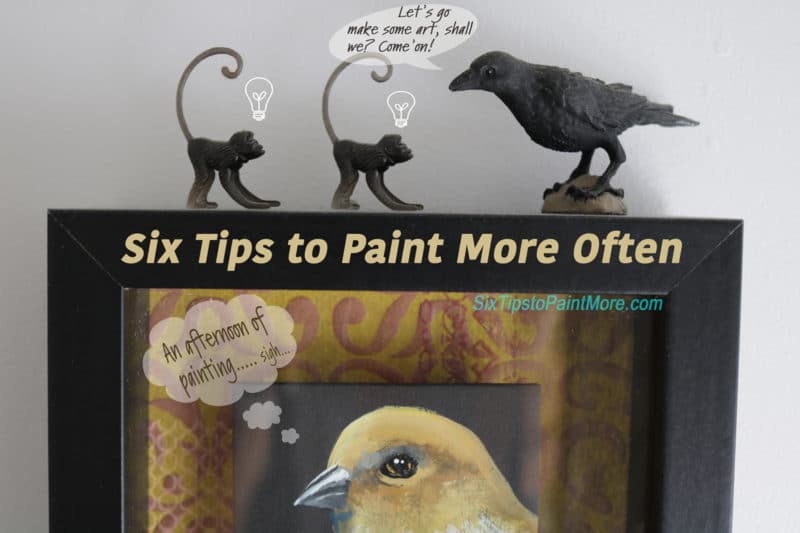Hand Color Linocuts
If you print your linocuts and woodcuts with inks that won’t re-wet, you can have a lot of fun hand coloring your relief prints with watercolors.

Hand Colored Block Print Fun
Let’s say you printed a small edition of 5 linocuts in black ink that dries permanently.
Once the ink is dry, you can have a party adding color to the parts of your paper that are free of ink.
And each print in the edition can be painted in different colors!

Printmaking Subjects
The Bill Elliott Swing Orchestra performed at an outdoor festival a few miles from our house. I took my son to the concert. He just a boy at the time, but he was/is a foot-tapping swing fan. We had a blast, listening to wonderful music, and watching swing dancers strut their stuff. I snapped a few photos that inspired this linocut.

If you’re looking for good subjects to use on your linocuts, read this linocut post. Take a look at the photos on your phone to see if they look interesting as a thumbnail. Those images are often just as fine to use as a woodcut or linocut.

Painting Your Prints
I carved this linocut of the band, based on my snapshots taken from the dance floor. After the ink was dry, I painted the print with watercolors.
If you have a folder or a drawer with old relief prints, can I invite you to pull them out, and have a look? Test the ink with a damp cotton swab to see if it re-wets. If the ink remains dry, and a swipe from a cotton swab comes away ink-free, you can paint that print. Bring on the color!

Adding Color to Prints with Dry Media
If you don’t have watercolors, you can add colored pencil or caran d’ache water soluble crayons to your prints too.
Test a swatch of ink on your print first. You might find – like I did – that most printmaking inks take colored pencils beautifully – even on the ink! Take a look at the linocut in this post to see colored pencil and watercolor on a black ink print.

Experimental Printmaking
You’ll see plenty of hard and fast rules about printmaking in Facebook Groups, Printmaking Manuals, and Online Courses. Most of the rules have a solid foundation in best practices or safety. Proper use of tools and best combinations or sequences will lead you towards a successful print. But some rules are just dumb. (There, I said it. )
A handful of purists will be agog that I’m suggesting hand coloring your relief prints. Knit brow questions will arise, asking of it’s still a print, or is it now a mixed media piece?
Here’s your answer: It’s still a print, my friend. It’s a linocut, with watercolor. Or a linocut with colored pencil.
Dive in. It’s fun, and the prints are nice with color. It’s that simple.
Play with your art supplies, and see if you can raise the level of your old relief prints to new heights that make you smile. At the very least, it will give you a few hours of simple, creative, colorful pleasure.

If you want to try making a linocut, here is a playlist on my youtube channel with relief printmaking demos and tutorials.
Happy printing!
Thanks for stopping by to say hello, and I’ll see you in the next post –
Belinda

This linocut is available in my Etsy shop.
Art Quote
Wyeth’s program could have been written by Fitz Hugh Lane: “to escape from the medium with which I work. To leave no residue of technical mannerisms to stand between my expression and the observer. To seek freedom through significant form and design rather than through the diversion of so called free and accidental brush handling.” We can also notice in Wyeth’s paintings those spacial conventions so frequent in Homer and Eakins, along with an interest in odd angles prompted by the camera eye, which often provides his idea of modern design.
B. Novak
Linocut Blog Posts
- Here’s a post featuring a small linocut still life and a video of Hilary Paynter’s wood engravings
- Friends have a beautiful black lab who posed for this dog profile linocut.
- Here is a post with a video showing a simple set up appropriate for a beginner linocut arrangement.
- Here is a two color linocut with a step by step process video.



What printing inks do you prefer for this purpose? Thanks
Hi Tamara, I have used both oil-based relief ink and water-clean up relief ink. They both work for adding watercolors, as long as the water-clean up inks dry permanently. There are several brands that carry both water-wash-up versions (re-wetting and permanent dry), so read your labels. You want inks that dry permanently.
Thank you, Belinda, I enjoy your demos, especially on Instagram! My printmaking buddies in Santa Barbara enjoy your works and teaching. So, I’ve a numbering question: I just pulled 44 prints of a linocut (yes, COVID-crazed holiday cards of a piece of Notre Dame stained glass), and I’m hand-painting each one with gouache. Do I still number them 1/44, 2/44, etc. even if the tinting is slightly varied? It looks like that’s how you’ve numbered your colored linocuts. I thought they become a one-of-a-kind print the moment you hand-colored, but it seems rather lofty to declare a humble greeting card at 1/1.
Hi Lori, Sunshine greetings from Ventura. Thanks for letting me know there are printmakers in SB experimenting with print methods so close by. Coastal printmakers, north and south, bumping long distance elbows from afar. That makes me smile.
Your Linocut of the stained glass sounds fantastic. You’ll be spreading delight to everyone who gets one of your cards. It’s a great idea.
Regarding editions, there are enough rules and terminology in printmaking to fill books. But it doesn’t mean you *have* to follow all of them to a T. It’s your choice. When you pull an edition, and you alter the prints with other media, you can mark the prints with an e.v. or E.V. It stands for “edition varies”. So, the edition number would look like 1/44 e.v. Does that make sense?
Oh wouldn’t that be the greatest! Your posts help me to be brave. Thanks, Belinda!
Hi Marie, Give it a twirl, and see what you think. Mostly, have fun with your art supplies! Thanks for your visit!
Belinda , your amazing . Keep up the good work of diversification
Warm & kind regards
Kenneth K .
( Napier / Hawkes bay / NZ )
PS I am already on your regular instalment site OK !
Hi Kenneth, Thanks for your visit and kind wishes from NZ! I’m glad to know we are connected across the miles by ART!
You so inspire me! 💕
We’re all linked arms and smiling at art supplies together, my friend!